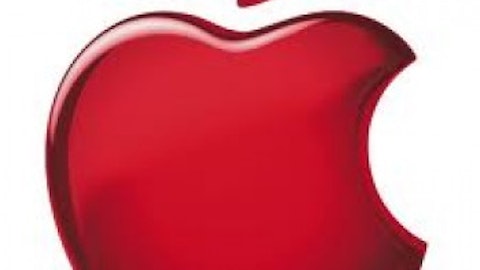How should investors trade the upheaval at Dell Inc. (NASDAQ:DELL) ? And will this upheaval be enough to convince founder Michael Dell and Silver Lake to up their $13.65 per share offer to take the tech company private? Well the market sure things so–the stock is trading almost 2% above the buyout price. Shareholder opposition to the buyout has been growing, with the two largest outside shareholders, Southeastern Asset Management and T. Rowe Price, publicly voicing their concerns.
I can certainly see why longer-term investors are upset.

Dell now trades at near multi-year lows, and for investors who bought the stock ten years ago, they have lost nearly 50% of their investment.
Momentum builds
Dell’s recent quarterly results showed a drop in both sales and earnings, which does not bode well for investors looking for a boost to valuation. Despite beating expectations, earnings were down 31% from the same quarter a year ago. The decline just further reaffirms the fact that Dell is under serious pressure related to its core PC business. Sterne Agee analysts notes that even with Dell’s initiatives to divest beyond the struggling PC market that “65% to 70% of its business is still tied to PCs.”
This is where things get interesting
So what makes the Dell buyout rejection even possible when founder Michael Dell is the largest shareholder with 14%? The deal includes a so-called majority-of-the-minority voting rights protection, meaning it must be approved by a majority of shareholders excluding Michael Dell’s 14% ownership. With major shareholders, including the top two outside share owners, voicing their opposition for the deal, there is reason to believe that enough support could be garnered to force Michael Dell and Silver Lake to boost their bid.
The growing opposition
Southeastern Asset Management and T. Rowe Price are Dell’s two largest outside shareholders, and both have publicly opposed the deal. Southeastern Asset Management and T. Rowe together own more than 10% of the stock and have said that Dell is worth more than its buyers have offered.
Here’s how the top five shareholders shake up:
| Owner | Shares Owned (in millions) | % Ownership |
| Michael Dell | 244.7 | 14.1% |
| Southeastern Asset Management | 147.2 | 7.2% |
| T. Rowe Price | 82.1 | 4.4% |
| Vanguard Group | 63.1 | 3.6% |
| State Street | 39.2 | 2.2% |
| Total | 576.3 | 31.5% |
Although Southeastern is a ‘low-key’ activist, they recently teamed up with billionaire activist Carl Icahn to implement changes at Chesapeake Energy. As for Dell, Southeastern believes that Dell could be worth upwards of $24, which they include in their shareholder letter.
Some believe that Southeastern could lose around $1 billion if the $13.65 deal goes through. Sanford Bernstein says the number could be larger. As a result, Southeastern has also put forth an alternative to the buyout, which includes Dell borrowing money to make a major share repurchase or break up the company and sell the units separately.
Another reason the opposition is worth looking into is that T. Rowe opposes the deal, where it is rather unique for a mutual fund company to stand against a management-backed deal. T. Rowe isn’t an activist fund, but they have a name and reputation that could gather more oppositional support. Pzena Investment Management also plans to oppose the deal, as well as Yachtman Asset Management. Another notable firm opposing the deal is Alpine Capital, stating that they expect the final price to be ‘meaningfully higher’ than the buyout price offered.
As mentioned, the deal must be approved by a majority vote not including Michael Dell’s shares. The four major funds that have come out against the deal, including Southeastern and T. Rowe, own 17.2% of Dell’s shares.
| Fund | Shares (in MM) | % Ownership (excluding Michael Dell) |
| Southeastern Asset Management | 147.2 | 9.8% |
| T. Rowe Price | 82.1 | 5.5% |
| Yactman Asset Management | 14.9 | 1.0% |
| Pzena Investment Management | 12.6 | 0.8% |
| Total | 256.8 | 17.2% |
How do the competitors stack up?
Hewlett-Packard Company (NYSE:HPQ) is Dell’s biggest competitor and one that has seen similar pressures due to a weak PC market. HP’s quarter ending in January confirmed some of these pressures: EPS was $0.82, compared to the $0.92 the company posted for the same quarter last year, and on the back of a 6% sales decline year over year. While we continue to debate whether the Dell buyout is fairly priced or not, HP could be out in the cold, where it’s trading at a much deeper discount to intrinsic value versus Dell (read more about why). This includes the potential for HP to spin off certain parts of its business, such as its printer segment, which could unlock value for shareholders.
The decline of Dell’s stock price is not unlike that of Xerox Corporation (NYSE:XRX) over the last thirteen years, which has been in steady decline.

The Xerox business model, not unlike that of Dell, has been suffering from serious changes in customer preference. This includes changes in how consumers send and store media. The decline in Xerox’s paper-related products and systems is a result of competition from companies such as HP and Canon. Xerox’s 4Q sales were down 14% and earnings were flat year over year. Last quarter, hedge fund manager Whitney Tilson and billionaire D.E. Shaw were selling off some of their shares (see all the activity here).
The variant view on the Dell deal
Sanford Bernstein suggest that around 20% of Dell’s shares are held by merger-arb investors, which indicates they will in all likelihood vote for the deal. They also add that around 8% of the shares are owned by passive index funds, who will also probably vote ‘yes’ for the deal. That’s roughly 28% that could vote yes. The premium, at $13.65, is 25% to Dell’s pre-announcement trading price. So investors should be happy with this, right? Well, as I mentioned above, many are not, and as a result it is worthwhile to consider what might happen if the deal falls apart. Jefferies notes that if the deal falls apart, the stock could fall to $10, but eventually rebound on a leveraged recap deal that could bump the stock back to $12 per share, which is a 13.6% fall from current levels.
The upside
There are a couple of scenarios, with one being the buyout happens at a higher price, likely around $15. The high-end of the price target range set by Wall Street analysts for Dell is upwards of $16. Jefferies also believes that the bid could be raised to $15.
The deal is already on the table at $13.65, with financing through Microsoft and Silverlake secured, so the likelihood of the deal falling apart lies in the shareholder vote. Assuming, for the sake of arguing, that the two key outcomes are the $13.65 buyout or an increased buyout at $15, and if you assume there is a 50/50 chance between the two, then the probability weighted return is 3.05%, a solid merger-arbitrage opportunity.
Don’t be fooled
I still see the buyout as one of Dell shareholders’ last hopes for seeing some returns in the interim. Merger-arb is a game played by hedge funds who have the capital to make money on small moves in the stock. However, with the backing of Dell’s two largest outside shareholders, Southeastern and T. Rowe, there could be a good chance that the buyout price gets boosted.
The article Dell’s Opposition Grows, But Is It Enough? originally appeared on Fool.com and is written by Marshall Hargrave.
Copyright © 1995 – 2013 The Motley Fool, LLC. All rights reserved. The Motley Fool has a disclosure policy.





